Vol 4 No. 30 TROPIC LIGHTNING NEWS July 28, 1969
Index
 |
| IN THE MORNING MIST Bravo Company, 2d Battalion, 27th Infantry, takes an eagle flight to a landing zone south of Go Dau Ha. (PHOTO BY SP4 KARL KARLGAARD) |
Tomahawks Work Out at Foot of Nui Ba Den
Arty, Tac Air Help
By SGT Roger Welt
TAY NINH - Twenty-four NVA soldiers died as action flared again
at the base of Nui Ba Den near Tay Ninh City.
Members of Company C, 4th Battalion (Mechanized), 23d Infantry,
were greeted with heavy small arms and automatic weapons fire as they swept
through the dense jungle at the base of the mountain.
Tomahawk infantrymen answered back with Lightning speed.
STILL MAINTAINING contact, the mechanized soldiers pulled back and
called in artillery, air strikes and mortars - a method of action that has
worked to perfection for the Tomahawks in their recent defense of the
Mountain's base.
The artillery answered the call with 105s, 155s and eight-inch
howitzers.
The air support included three light fire teams and one air strike.
Four-deuce and 81 millimeter mortarmen kept the tubes hot as they pumped out the
rounds.
AFTER SATURATING the area with the heavy array of ordnance, the
Tomahawks advanced on the enemy position. Once again they were met with
machinegun fire, this time from one position.
"That enemy machinegunner didn't last long. A few bursts
and that was it. My men zeroed in on him before he knew what hit him,"
said Captain Arthur Minnefield, Charlie Company Commander from Anderson, Ind.
Alpha Company, sweeping on C Company's right flank, contributed
four to the body count as an alert infantryman spotted movement to his front.
Two dusters and 81mm mortars soaked the area, killing four surprised enemy.
The Tomahawks have been keeping a tight noose around this area.
The jungles at the base of the Black Virgin provide excellent concealment for
the enemy. The vicinity is often used as a staging area before an enemy
attack is launched against Tay Ninh.
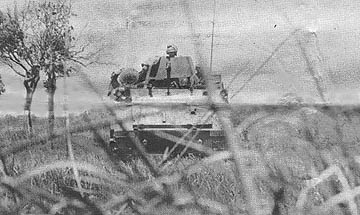 |
A VC EYE VIEW - Sergeant Roger Welt took this shot of a Tomahawk armored personnel carrier sweeping in the area of recent 4/23d contact.. |
Manchus Foreclose On Cong's Estate
By PFC Richard Sears
TAY NINH - While on a sweep eight miles south of Tay Ninh City,
soldiers from Bravo Company, 4th Battalion, 9th Infantry, located and destroyed
a huge enemy bunker complex containing more than 100 bunkers. The complex
lay deep in the triple-canopied Straight Edge Woods.
The bunkers looked as though they had been built within 48 hours of
their discovery by the Tropic Lightning soldiers. They were totally
deserted. Strewn throughout the area were empty fish cans, cigarette
butts, plastic nose protectors from RPG rounds, and clothing.
The Manchus of the 4/9th flew into the area on an eagle flight to
the northern edge of the woods, where they began chopping their way into the
dense jungle. The troopers first located fresh fighting positions, and as
they pushed on, they uncovered the bunkers.
There were eight command bunkers, measuring 10 feet by 10 feet and
eight feet deep. The other bunkers were two feet by four feet and all had
heavy overhead cover. Also each bunker had a five-foot tunnel leading into
it.
"Engineers working with the battalion blew as many of the bunkers
as they could in the time we had," said Lieutenant Colonel John R. Randolph of
Columbus, Ga., "but it was just too big for them to finish before our eagle
flight was to pick us up."
Air strikes and artillery worked over the area the rest of of the
night, and the complex was fully destroyed.
| During a year's tour, the average GI will take over 400 daily and weekly malaria pills. It's worth the trouble. |
| A STEEL POT DOES WORK - Private First Class Charles Crawford, from Delta Company, 4th Battalion, 9th Infantry Manchus received a hole in his steel pot from an AK round during a firefight 15 miles southwest of Tay Ninh City. Crawford, a Tampa, Fla., native, is alive today because he used the proper equipment. (PHOTO BY PFC RICHARD SEARS) | 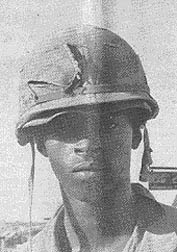 |
Light in the Bananas
By PFC Sam Dixon
TAY NINH - From a night defensive position at the base of Nui Ba Den, Alpha
Company, 4th Battalion (Mechanized), 23d Infantry put the squeeze on the enemy,
killing five Viet Cong.
The slopes leading up to the sacred mountain are covered with a
dense growth of banana trees and the 4/23d Tomahawks have had frequent contact
with enemy forces in recent weeks.
Early in the morning, alert Tomahawks spotted moving light in the
banana trees. The lights gave away the Viet Cong position. The
Tropic Lightning soldiers waited, then opened up with their .50 caliber
machineguns.
Captain Jon Blades of Schofield Barracks, Hawaii, commanding
officer of Alpha Company, said, "It looked like the VC had no idea where their
target was in this case, the good cover usually given by banana groves worked
against them. They couldn't see out."
The Viet Cong withdrew to the higher slopes of the mountain seeking
cover and concealment among rocks and crevices.
In the faint light of morning, the Tomahawks swept through the
area, finding the five enemy bodies.
Page 2 TROPIC LIGHTNING NEWS July 28, 1969
Decorated
| SILVER STAR MEDAL | |
|
LTC Robert B. Carmichael, HHC, 3d Bn, 22nd Inf CPT Ronald M. Chatelain, HHC, 1st Bn, 5th Inf CPT John W. Gray, Jr., Co A, 3d Bn, 22nd Inf CPT Richard C. Pouch, Co A, 25th Avn Bn 1LT Edward L. Behne, Co A, 25th Avn Bn 1LT Lawrence L. Rupp, Co E, 2d Bn, 12th Inf 1LT Edward L. Bruton, HHC, 2d Bn, 34th Armor 2LT Allen H. Beiner, Co, D, 4th Bn, 9th Inf WO1 Robert P. Shandley, D Trp, 3d Sqdn, 4th Cav WO1 Andrew J. Elliott, D Trp, 3d Sqdn, 4th Cav 1SG William J. Novajosky, Co B, 3d Bn, 22 Inf SFC Lawrence W. Allen, Co C, 4th Bn, 23d Inf SFC Jose Rivera-Hernandez, Co C, 4th Bn, 9th Inf |
SFC Antonio C. Flores, Co A, 2d Bn, 34th Armor SSG Donald Higginbotham, Co C 2d Bn, 14th Inf SSG Calvin C. Rice, B Trp, 3d Sqdn, 4th Cav SP5 John P. Beckers, Co A, 65th Engr Bn SP4 Joseph Valesko, Co A, 3d Bn, 22d Inf SP4 Luis J. Guerena, D Trp, 3d Sqdn, 4th Cav SP4 James E. Dundon, B Trp, 3d Sqdn, 4th Cav PFC Louie V. Sanchez, C Trp, 3d Sqdn, 4th Cav PFC Floyd D. Wimer, C Trp, 3d Sqdn, 4th Cav PFC James A. Mardis, Co C, 1st Bn, 5th Inf PFC David P. Callahan, Co C, 1st Bn, 5th Inf PVT George B. Tullos, Co A, 2d Bn, 12th Inf |
| BRONZE STAR MEDAL (HEROISM) |
|
|
1LT Hugh E. Stephens, HHC, 3d Bn, 22d Inf 1LT Don R. Bradley, Jr., A Btry, 2d Bn, 77th Arty SSG Joseph W. Clock, HHC, 2d Bn, 34th Armor SGT Ronald P. Duran, A Btry, 7th Bn, 11th Arty SGT Thomas G. Stidham, Co E, 2d Bn, 12th Inf SGT Roger E. Edmond, A Btry, 7th Bn, 11th Arty SGT John L. Clark, A Btry, 7th Bn, 11th Arty SP5 Berne G. Ellis, Co A, 65th Engr Bn SP5 Joseph J. Tamblyn, B Trp, 3d Sqdn, 4th Cav SP5 Edmund T. Mooney, B Trp, 3d Sqdn, 4th Cav CPL Michael S. Cziska, A Btry, 7th Bn, 11th Arty CPL Charles Kiniyalocts, Co C, 1st Bn, 5th Inf SP4 Larry F. Young, C Trp, 3d Sqdn, 4th Cav SP4 Eugene A. Bihn, Co C, 4th Bn, 23d Inf SP4 David N. Brinton, Co B, 65th Engr Bn SP4 Norman R. Puckett, Co C, 4th Bn 23d Inf SP4 Troy L. Boomer, Co C, 4th Bn, 23d Inf SP4 John R. Scriven, A Trp, 3d Sqdn, 4th Cav |
SP4 Gregorio V. Lopez, A Btry, 7th Bn, 11th Arty SP4 Thomas G. Hird, B Trp, 3d Sqdn, 4th Cav SP4 Donald Heike, Co E, 2d Bn, 12th Inf SP4 Larry D. Mette, A Btry, 7th Bn, 11th Arty SP4 David A. Suddeth, B Trp, 3d Sqdn, 4th Cav PFC James D. Zebert, Co B, 4th Bn, 23d Inf PFC Ernest D. Bowling, B Trp, 3d Sqdn, 4th Cav PFC Ronald W. Robinson, Co C, 4th Bn, 9th Inf PFC William D. Ruff, C Trp, 3d Sqdn, 4th Cav PFC Joseph D. Graham, A Trp, 3d Sqdn, 4th Cav PFC Terry L. Cook, Co C, 4th Bn, 23d Inf PFC David Deitch, Co B, 4th Bn, 9th Inf PFC David A. Madden, Co C, 4th Bn, 23d Inf PFC Stephen L. McGinnis, Co C, 1st Bn, 5th Inf PFC Gary D. Bender, HHC, 1st Bde PFC Gene R. Harris, Co E, 2d Bn, 12th Inf PFC Robert D. Ledesma, Co C, 4th Bn, 23d Inf PFC Cordell Grove, Co B, 4th Bn, 23d Inf |
| ARMY COMMENDATION MEDAL (HEROISM) |
|
|
SSG Calvin C. Rice, B Trp, 3d Sqdn, 4th Cav SGT Charles F. Clendenin, HHC, 2d Bn, 34th Armor SP5 Anthony D. Masi, C Trp, 3d Sqdn, 4th Cav SP5 Don Davies, HHC, 2d Bn, 34th Armor CPL Daniel L. Mafredas, B Trp, 3d Sqdn, 4th Cav SP4 Ronnie R. Moser, A Btry, 7th Bn, 11th Arty SP4 Glen F. Moorman, A Btry, 7th Bn, 11th Arty SP4 Herbert Lottes, HHC, 2d Bn, 34th Armor SP4 Richard A. Daly, HHC, 3d Bn, 22d Inf SP4 Courtney Cosgrove, HHC, 2d Bn, 34th Armor |
PFC Roy L. Walker, Co D, 2d Bn, 12th Inf PFC Cordell B. Simms, A Btry, 7th Bn, 11th Arty PFC Terry E. Toole, Co D, 2d Bn, 12th Inf PFC Arthur D. Jankowski, A Btry, 7th Bn, 11th Arty PFC Lonnie P. Hensley, A Btry, 7th Bn, 11th Arty PFC Calvin E. McCarver, A Btry, 7th Bn, 11th Arty PFC Thomas C. McCullen, A Btry, 7th Bn, 11th Arty PFC James B. Mills, A Btry, 7th Bn, 11th Arty PFC Duane M. Moser, A Btry, 7th Bn, 1 l th Arty PFC Ronald J. Wood, A Btry 7th Bn, 11th Arty |
RVN Vets Get State Bonuses
Not only Uncle Sam has bennies available to you when you return to
the world, but your own state may offer you special considerations.
Currently, there are six states that authorize state bonuses for
Vietnam veterans. They are Connecticut, Delaware, Illinois, Louisiana,
Massachusetts and Pennsylvania.
Requirements for collecting the bonuses vary slightly from state to
state. Generally, in order for one to collect he must have been a resident
of the state at time of induction into the armed service. (Some states require a
year's residency.)
The amount of the bonuses also varies. Connecticut pays $10
for each month's service in Vietnam for a maximum of 30 months.
Residents of Delaware can collect $20 per month with a $300 limit.
Illinois and Louisiana pay $100 and $250 respectively. And if you're
from Massachusetts, get ready to collect $300.
Pennsylvania has the highest ceiling. That state allows $25
dollars per month of service in Vietnam with a limit of $750.
If your state does not yet offer a Vietnam bonus, don't give up
hope of collecting on this bennie. The list is growing every year the war
continues.
In case there is a doubt about residency, application, should be
made to allow state officials to determine whether a person is a bona fide
resident.
Many states that do not traditionally authorize cash bonuses for
veterans of periods of armed conflict do, instead, offer other benefits, such as
property tax advantages, special farm or home loans and job preferences.
If you are interested in what may be available from your home state, write to
the veterans affairs office at your state capital.
The bennies are just beginning to roll in.
Think About It
You say you've only been in the Army for 17 months and already
you're surprised by all of the bennies? Well, there's a lot more where they came from if you decide to
take a burst of three, four or six. If you have an MOS in the series 31, 67, 68 or 91, you may be
eligible for a $10,000 Re-Up bonus. Are you good enough??? Think about it.
TROPIC LIGHTNING
Combat Honor Roll
Platoon sergeant John J. Weiss of C Troop, 3d Squadron, 4th
Cavalry, is added to the Tropic Lightning Honor Roll this week for his valorous
actions on June 19, 1969.
While on a reconnaissance-in-force mission, C Troop discovered an
enemy bunker complex. While investigating, the Troop came under intense
hostile fire from a well-entrenched enemy force.
As Sergeant Weiss led his men into the aggressors' stronghold, he
spotted an enemy bunker that had to be destroyed before his men could advance.
Sergeant Weiss assaulted the emplacement and destroyed it by
throwing several hand grenades. The area was heavily mined, but Sergeant
Weiss once again advanced on the insurgents, throwing grenades and firing his
rifle, and destroyed a second enemy position.
Exposed to deadly hostile fire, he led his men through the area,
investigating spider holes and providing covering fire for the rest of C Troop.
Sergeant Weiss determined where the most strategic enemy stronghold
was and crawled forward to eliminate yet another enemy emplacement and its
occupants.
For his heroic actions, Sergeant Weiss was awarded the Silver Star
by Major General Ellis W. Williamson on July 18.
Tropic Lightning Tots
The Commanding General Welcomes
The Following Tropic Lightning Tots
To The 25th Infantry Division – As
Reported By The American Red Cross.
Born To:
June 24
SP4 Thomas Vick, HHC 725th Maint Bn, a daughter
June 26
SP4 Edward M. Skinner, B Btry, 3d Bn, 13th Arty, a son
June 27
SP4 Ralph I. Frazier, D Co, 725th Maint Bn, a son
June 28
SP4 Gordon Cronce, HHC 1st Bn (Mech), 5th Inf, a son,
June 30
2LT Clark O. Benedict, A Co, 2d Bn, 27th Inf, a daughter
July 1
PFC Oliver Prothro, A Co, 1st Bn (Mech), 5th Inf, a daughter
July 2
SP4 Richard Weber, B Co, 554th Engr Bn, a daughter
July 3
SP4 Evardo Alamillo, D Co, 2d Bn, 14th Inf, a sonJuly 3
SP4 William R. McClullough, HHC, 25th Inf Div, a son
July 4
SP4 Raymond Goodyear, B Btry, 5th Bn, 2d Arty, a son
SP4 Cecil May, 25th MP Co, a daughter
PVT Arthur Edwards, B Co, 554th Engr Bn, a son
July 5
1LT James A. Lake, HHC, 25th Avn Bn, a daughter
CPT Harley J. Manchester, B Co, 1st 27th Inf, a son
July 7
SP4 William T. Hamilton, HHC 554th Engr Bn, a daughter
PFC Kenneth E. Seiler HHB 2d Bn, 77th Arty, a daughter
July 8
CPT John A. Rockensies HHC, 2d Bde, a daughter
SGT Larry A. Owens, B Co, 25th Avn Bn, a daughter
SP4 Dennis J. Beaupre, Co A, 725th Maint Bn, a son
July 9
SSG Mack Togisala, B Btry 3d Bn, 13th Arty, a daughter
The TROPIC LIGHTNING NEWS is an authorized publication of the 25th Infantry Division. It is published weekly for all division units in the Republic of Vietnam by the Information Office, 25th Infantry Division, APO San Francisco 96225. Army News Features, Army Photo Features, Armed Forces Press Service and Armed Forces News Bureau material are used. Views and opinions expressed are not necessarily those of the Department of the Army. Printed in Tokyo, Japan, by Pacific Stars and Stripes.
MG Ellis W. Williamson . . . . Commanding General
MAJ John C. Fairbank . . . . . Information Officer
1LT John C. Burns . . . . . . . . Officer-in-Charge
SP5 Charles Withrow . . . . . . Editor
SP4 David DeMauro . . . . . . . Asst. Editor
SP4 Ralph Novak . . . . . . . . . Production Supervisor
BATTALION CORRESPONDENTS
SGT Jan Anderson
PFC Ken Baron
SP4 Arthur Brown
PFC Larry Goodson
SP4 Richard Huhta
PFC Phil Jackson
PFC Craig Sampson1/5
1/8
2/12
2/12
2/14
2/27
2/27SP5 Doug Elliott
PFC Steve Duncan
SP4 K.C. Cullen
PFC Dan Stone
SGT Roger Welt
SP4 Pete Freeman2/34
3/4
3/22
4/9
4/23
7/11
Page 3 TROPIC LIGHTNING NEWS July 28, 1969
ARVNs Learn to Handle Weapons of War
In Classes at Tay Ninh
By SP4 Rick Mizdal
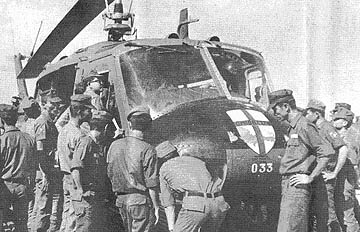 TAY NINH - What doesn't an ARVN officer know about U.S. Army
equipment that he needs to know?
TAY NINH - What doesn't an ARVN officer know about U.S. Army
equipment that he needs to know?
How much ammunition does a Cobra gunship carry? What's the
range of an eight-inch howitzer? How does one attempt to ride atop an
armored personnel carrier?
All these questions and many more were asked by 38 ARVN officers
and five faculty members of the Ben Keo Training School on their tour of the
facilities of Tay Ninh West Base Camp.
The purpose of the ARVN officers' tour was to thoroughly
familiarize them with American combat equipment that they will use in combined
operations with U.S. Forces.
The ARVN officers were shown eight-inch howitzers and supporting
gunships. They also learned about mechanized infantry units. After a
welcome by Colonel Charles Hayward, commander of the 1st Brigade, the group was
shown Tay Ninh West's artillery complex. They received translated
lectures as well as demonstrations on eight-inch howitzers and 175mm guns.
At the airfield the ARVN officers also viewed helicopter
demonstrations. Their tour ended with an introduction to the Tomahawks of
the 4th Battalion (Mechanized), 23d Infantry, and their armored personnel
carriers.
HUEY VIEW - (Above) ARVN officers receive a briefing on this
chopper at Tay Ninh base camp. (PHOTO BY SP4 RICK MIZDAL)
Fire Bde, ARVNs, Nat. Police Work as Team
Combined Forces Rid Trung An of Cong
By SP5 Doug Elliott
CU CHI - Elements of the 2d Brigade, Vietnamese soldiers and
National Police combined forces to remove hardcore Viet Cong from Trung An
Village.
Trung An is located four miles southwest of Cu Chi on Highway 8A.
The Viet Cong were known to be using the village as a base of operations for an
area of rugged terrain northeast of Cu Chi known as the Spider Web.
ARMOR WAS supplied by Headquarters Company, 2d Battalion, 34th
Armor's tank and reconnaissance platoons, and by the attached reconnaissance
platoon from the 1st Battalion, 17th Cavalry. Infantry forces came from
the 82d Airborne's Company C and Regional Force soldiers and National Police
from the Phu Hoa District.
In addition, other units from the 505th Airborne swept south of
Trung An to complete the squeeze on the enemy. Planning had been laid down
to the most minute details of the operation.
At one o'clock on the morning of the start of the mission, the
combined armored column swept out of Fire Support Base Emory and roared down
Highway 8A. Reaching the edge of Trung An Village, the U.S.-Vietnamese
mounted forces swept to the left and right of the settlement, encircled it, and
secured their positions.
THE NIGHT-LONG vigil to ensnare the Viet Cong in the village had
begun. Several times movement was spotted, but the Viet Cong could not
find a way to break out of the village. The minutes of the night ticked
away.
At first light, a tent was erected in the south end of the village,
while National Police and Regional Forces soldiers searched the village.
The American personnel kept the villagers isolated by their cordon.
No one left the village, and no one got into it. Suspects
were taken to the tent on the outskirts of town, where they were checked
individually. Two men and one woman were arrested and accused of having
operated in the tunnel complexes of the Spider Web.
Four other Vietnamese were detained for questioning because of
illegal residence in the village and improper ID cards. The sifting of the
guerrilla from the civilian is a continuing job for combined U.S.-Vietnamese
forces.
VC Lose Big Ammo, Rice Cache
TAY NINH - Working separately in areas south of Tay
Ninh, two
companies from the 4th Battalion, 9th Infantry, found caches in enemy bunkers
that included rice and ammunition.
Charlie Company of the 4/9 Manchus found the first cache while on a
sweep near Fire Support Base Stoneman, 16 miles southeast of Tay Ninh City.
The find included a ton and a half of rice.
"I never saw so much rice in all my life," commented Private
First Class David J. Guest of Medford, N.J.
The cache also contained forty-eight 60mm mortar rounds,
twenty-four 82mm mortar rounds, two hundred and fifty .51 caliber machine gun
rounds and five RPG rounds.
Across the Vam Co Dong River, Alpha Company Manchus chopping
through the Renegade Woods found a battalion-size bunker complex. The
largest bunker measured 20 feet by 20 feet, with 18 inches of overhead cover.
It was six feet deep. There were 135 smaller bunkers, most measuring
approximately five feet by five feet. They were scattered throughout the
area.
Dreadnaughts Blast Tunnels
CU CHI - Tan Hoa village, located along Highway 8A, two miles from
Cu Chi, has been abandoned for more than a year. All that remains is a few
clay-walled hootches partially destroyed.
Periodically the men of the 2d Battalion, 34th Armor's
Headquarters Company, sweep the area and often return with enemy suspects,
weapons and ammunition. In the past, the battalion has captured small arms
weapons, 122mm rockets, documents and even suspected members of the Viet Cong
infrastructure.
RECENTLY THE Dreadnaught company's tracks and recon vehicles
joined two companies of Vietnamese Regional Forces soldiers and a MACV advisory
team in reshuffling the village's bunkers. The result was the capture of
a B-40 rocket launcher, a cooking stove, assorted foods, three sets of black
pajamas, one carbine rifle and two Chicom grenades. Four suspected members
of the Viet Cong infrastructure were detained.
First Lieutenant Carl W. Grabeel of Dallas, Tex., platoon leader of
the Dreadnaughts' Headquarters Tank Section, tells of the operation's
initial moves at seven o'clock in the morning: "We took 15 tracks and tanks
to the pick-up point at Peri Tan Qui and loaded the Vietnamese soldiers aboard
our vehicles. Running down Highway 8A, we dropped the RF troopers off
south of Tan Hoa to begin their operation.
"We then swept around to the far side of the village," said
Grabeel. "Once on the far side, we moved into a blocking position to
seal off all routes of escape."
SECOND LIEUTENANT John T. Aiken of Greenfield, Tenn., forward
observer for the Dreadnaught battalion, told about the actual sweep: "We put
our blocking force in a semicircle outside the old village. Elements from
two RF companies split up and approached the village from both sides."
"The RFs," continued Aiken, "then drove all that was in front
of them toward the blocking force. At times, the Vietnamese were past
their waists in water, but they pushed on in spite of it. These soldiers
really showed spirit."
The first suspect detained led the RF soldiers to his wife in
another tunnel. Both suspects were questioned as the sweep continued.
As more and more of the tunnels were located, two more suspects were caught,
along with their weapons, food and ammunition.
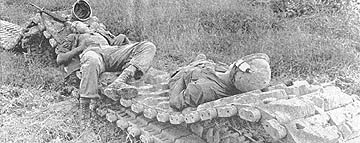 |
JUST LIKE HOWARD JOHNSON'S - Two Wolfhounds, Private First Class Fred Thatcher of Milan, Mich., and Specialist 4 Cecil Miller of Brooklyn, find that even a thrown track can be comfortable if you're tired enough. (PHOTO BY SP4 JOHN HAYDOCK) |
Page 4-5 TROPIC LIGHTNING NEWS July 28, 1969
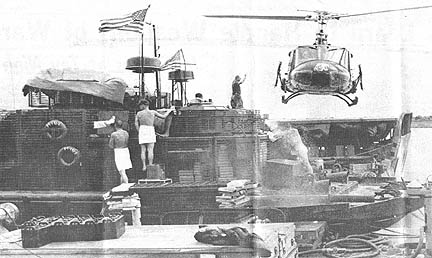 |
LIFE ON THE VAM CO DONG - As a sailor takes a shower on his "Zippo" patrol boat, a chopper comes in for a deck landing with the afternoon mail. The setting is on the Vam Co Dong River, four miles south of Tay Ninh, where the 531st River Division is working with Tropic Lightning forces to effectively stop enemy infiltration. |
| ARTILLERY FO - First Lieutenant Daniel L. Putman of Yuba City, Calif., observes and adjusts the artillery fire he called in on enemy positions across the river. Putman is an artillery forward observer with the 7th Battalion, 11th Field Artillery, who is currently working with the Navy calling in direct artillery support for all of their operations. | 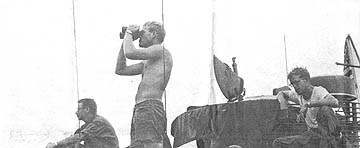 |
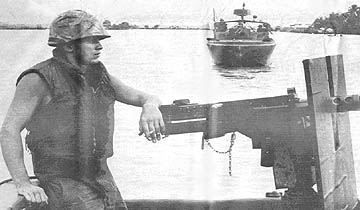 |
A Navy machinegunner scans the river bank for signs of enemy activity while on patrol near Ben Soi, formerly a popular river crossing point for enemy infiltrators planning a trip on Highway 13. |
Army, Navy Team Up for 'Slingshot'
Photo Feature by SP4 Pete Freeman
TAY NINH - Imagine a night ambush patrol set up 20 miles from its
support base. Sound strange? It was, until the U.S. Navy began
Operation Slingshot, which brought it all the way from the Mekong Delta up north
into Tay Ninh Province.
Just recently, the Navy's 531st River Division set up a base of
operations on the Vam Co Dong River at a location four miles south of Tay. Ninh
City.
With nine boats and about 60 men, the 531st is responsible for
patrolling 40 miles of river. They were sent up to work with the 1st
Brigade in helping stop enemy infiltration across the stream. Enemy
infiltrators must cross the Vam Co Dong in order to proceed toward Tay Ninh, a
major commerce center and an attractive enemy target.
In the past, Charlie more or less owned the waterways in the area.
At night he used the river as a means of transporting troops, weapons and
supplies. Now, the enemy has been denied the use of the main waterways in Tay Ninh Province, which
has greatly reduced his effectiveness.
Every night, boats are sent out on night ambush patrol, sometimes
patrolling as far as 30 miles up river. In their first week of operation,
they were involved in eight fire fights.
On their first night ambush patrol, the boats were responsible for
turning back an estimated NVA Regiment near Ben Soi. Until that first
night, the enemy could cross the river quite easily, especially at night.
After losing a number of sampans and personnel, the NVA soon realized they had
no chance of crossing the river and withdrew.
Like all units operating in Tay Ninh Province, the Navy receives
great support from Army artillery and gunships. Working with the 531st is
First Lieutenant Daniel L. Putman of Yuba City, Calif., a Tropic Lightning
forward observer with the 7th Battalion, 11th Field Artillery.
Putman calls in artillery from nearby fire support bases to support
the patrol boats when they make contact or to provide blocking fire as they
patrol up river. Operating from the communications boat at the base,
Putman can provide effective artillery fire anywhere along the river within
seconds after the boats make contact.
"The Navy was given a tremendous task to perform this far
inland," said Putman. "They are operating a great distance from their
own support units. Consequently they must depend on support from the Army.
It is my job to show them how to make maximum use of artillery support."
The 531st River Division is commanded by Lieutenant Colonel Thomas
K. Anderson of Eugene, Ore. About their work in the 1st Brigade area of
operations, Anderson said: "After operating independently on other operations
north of the Mekong Delta we greatly appreciate the Army support we are getting
here. Teaming together with direct artillery support has produced great
results. In addition, the Army has been extremely helpful in supplying us
with ammunition and anything else we need, making Operation Slingshot the best
one we've had."
 |
| Equipped with five .50 caliber machineguns, this patrol boat searches the shoreline. |
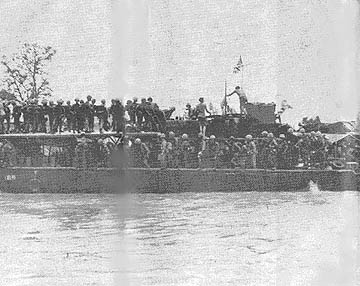 |
The U.S. Navy transports ARVN Marines to an area five miles south of Tay Ninh for a sweep. |
| A river patrol searches for enemy bunkers and hidden supply points. | 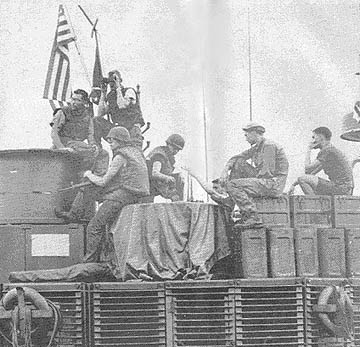 |
 |
| Two U.S. Navy river patrol boats along with three South Vietnamese Navy boats head out on a morning patrol which will take them some 25 miles up the Vam Co Dong River. |
Page 6 TROPIC LIGHTNING NEWS July 28, 1969
3d Bde Troops Aid Dau Tieng Orphans
CU CHI - More than a thousand dollars was donated recently by
troops of Tropic Lightning's 3d Brigade for a proposed orphanage near the
brigade's former base camp at Dau Tieng.
The orphanage idea came about when the brigade staff chaplain,
Major D. Clifton Banks of El Paso, Tex., took personal interest in four children
in Dau Tieng after their mother had been killed by an enemy rocket earlier in
the year.
When Banks investigated the situation further, he discovered that
the children had no living relatives. Immediately, Banks went to Major
Nguyen Ngoc Chau, Tri Tam District Chief, to find out what could be done for the four orphaned
youngsters.
At the district office, Banks found out there were 50 more orphaned
children in much the same plight as the four he had taken under his wing.
Roles were rapidly reversed, and it was Major Chau who asked Banks for
assistance in finding a home for the children.
Banks responded with a request for a donation to begin work on an
orphanage in the Dau Tieng area. There was already $300 in the fund, and
brigade troops put in more than $700 to start the ball rolling. Banks'
wife started a similar collection in El Paso.
Construction of the orphanage is in progress now.
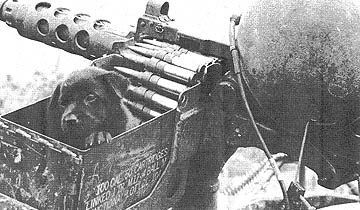 |
I GOTTA GET OUT OF THIS PLACE might be the cry from A Company, 2/34th Armor's newly enlisted mascot. |
Phu Hoa Stays Safe
CU CHI - The men of the 2d Battalion, 34th Armor, are helping the
Vietnamese accomplish their goal of peace.
Training teams that give practical help to the villages in the Phu
Hoa District are parts of the Dreadnaught program.
Captain James Crocker of Hubert, N.C., is part of a MACV advisory
team. His team works in the District along with the 2d Battalion, 34th
Armor.
SAYS CROCKER: "We run combined operations both day and night with
Tropic Lightning Armor."
"We have an average of three combined daylight missions and two
combined night missions a week," continued Crocker. "Reaction forces
for night contacts are usually Vietnamese Infantry and 2/34th Dreadnaught
Armor."
Another side of the fighting force is led by 1st Lieutenant Edward
L. Bruton of Troy, N.C. A platoon leader of the Dreadnaught scout platoon,
Bruton and his men work directly with the Province Reconnaissance Unit.
"The PRU's enthusiasm and interest in the people sparks our men
to do the best job possible," said Bruton. "With our combined
information sources, we have been able to stop many Viet Cong."
Furthermore, the aid in combat arms is no longer one-sided.
Because of some of the area's swampy terrain, the Dreadnaught Armor often
relies on the Regional Forces and the Popular Forces for infantry striking
power. The Vietnamese units, according to Crocker, are now ready to "go
out and jump on the Viet Cong day or night". It is a dramatic
improvement. The people see their own forces becoming more effective.
They then feel greater security and firmer backing because of it."
AS THE MAIN force Viet Cong are driven away from the populated
areas, there is still the problem of the Viet Cong Infrastructure (VCI).
The VCI can continue to rule the people by sneaking into the villages and
hamlets at night to collect taxes, give propaganda lectures and terrorize the
villagers.
The Province Reconnaissance Unit and the Village Self-Defense Teams
are prime instruments in defeating the infrastructure. In recent months,
the VCI has entered only one village in the Phu Hoa District.
The combined rapid reaction force drove them back out before the
Viet Cong could collect taxes or forcibly remove the village youth to join their
ranks.
This success is a product of the U.S.-Vietnamese soldiers, working
together. "I think," continued Crocker, "we are doing a good job here. A
year ago, nightly attacks were common. Now, this is no longer true.
An example is the Tan Who Village Self-Defense Team. Villagers of all ages
are now volunteering to take arms and aid in defense.
"A YEAR AGO, that would have been suicide. The people now
feel that there is someone to give them a helping hand. It is an
expression of confidence from the people to their government and the free world
forces."
The second front of the war, political and economic security, is
also important to the pacification program. Once the hamlets have been
secured, the people can develop their economic and political systems.
To do this the Government of the Republic of Vietnam, its Army, and
the U.S. Forces work together. Elections were held for Phu Hoa District in
April. For the first time, all the villages and hamlets have a truly
elected government.
In the Phu Hoa District, the 2/34th Armor and ARVN forces still
help by giving advice, when required, on construction and sanitation, lending
the use of heavy equipment, and assistance in getting materials.
Pooch Packs For Florida
CU CHI - It's not uncommon to hear of a short-timer GI getting
decorated before leaving country, but a dog?
His name is Scouter and he is owned by Specialist 4 James Grant of
Jacksonville, Fla., a 3d Brigade soldier. Grant said that he got Scouter
when he was just a pup. "He has been a great 'friend and morale
booster," said Grant.
Scouter pulls a lot of duty. "He pulled bunker guard every night
in Dau Tieng when we were there," said Grant. "He is the first one in
the chow line every morning."
Scouter earned a purple heart on June 15 during a heavy rocket
attack on Dau Tieng. "He was running for a bunker when a 107mm rocket
landed about 20 meters away," said Grant. "He took a piece of shrapnel
in the chest. It's a good thing it wasn't serious. I'd hate to
see him dusted off to Japan."
Today Scouter is happy and healthy. With just a few days to
go, Grant is taking his dog back to the U.S. "I didn't have the heart
to leave him behind."
Page 7 TROPIC LIGHTNING NEWS July 28, 1969
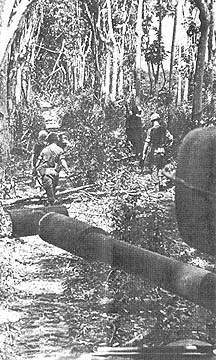 Crescent Is Starting Point
Crescent Is Starting Point
Rome Plow Everything!
By SP5 Doug Elliott
and
SP4 Carl Detrick
TAY NINH - The Crescent area, 13 miles east of Tay Ninh City,
became Charlie's paradise. Double- and triple-canopied jungles in the
area have long hampered allied air observations and mechanized sweeps.
Enemy forces used the Crescent to pass heavy loads of arms and
munitions to their soldiers operating from Tay Ninh to Saigon. The jungle
also doubled as a staging area and as a refuge from combat.
Thanks in large part to a group of Tropic Lightning soldiers,
however, the Crescent is gradually losing its appeal to Charles. Over
9,000 acres of thick jungle are being cleared in an effort to end their
usefulness for the enemy.
Elements involved in the clearing operation include the 2d
Battalion, 34th Armor, Charlie Company of the 2d Battalion (Mechanized), 22d
Infantry, and 28 rome plows from II Field Force's 60th Land Clearing Company.
The joint force is commanded by Lieutenant Colonel T.G. Smith of El Paso, Tex.,
commanding officer of the 2d Battalion, 34th Armor.
"This is the end of the Crescent story for the enemy," said
Smith. "Charlie is losing his staging areas, supply routes, and a place to
lick his wounds. The morass of fallen jungle will make his passing
extremely difficult. When we are finished, air observation of enemy
movement in the area will be easy."
Using a leap frog method, the land clearing operation moves into an
area of dense growth, clears out a night defensive position, then mows down all
the surrounding area. Tanks and personnel carriers from the Dreadnaught
Armor and tracks from Charlie Triple Deuce provide security for the daylight
cutting operations and the night defensive positions.
The joint operation has met little resistance from the enemy.
The force has found numerous fighting positions and hastily abandoned equipment,
indicating that Charlie still lives nearby. Armored sweeps of the area
have made contact with scattered enemy forces.
The clearing operation may also provide other benefits to the
people of Tay Ninh Province besides ridding them of an enemy staging and hiding
ground.
Says Smith, "When the war ends, this cleared land can be
cultivated for the first time, and by removing the jungle, we are also ridding
Tay Ninh Province of a heavily infested vermin and pestilence breeding area.
In fact, the areas of our night defensive positions, once cleared, are large
enough to build a village within their confines. A farmer could not
possibly remove a triple-canopied jungle by himself, nor could he afford to rent
a bulldozer for even a day. When peace comes, the area will be open for
many people to live and work."
SWEEPING SHADED TRAILS - (Above, right) Engineers check for mines and
booby traps while Headquarters and Alpha Company tanks from the 2d Brigade, 34th
Armor, secure the area. (PHOTO BY SP5 DOUG ELLIOTT)
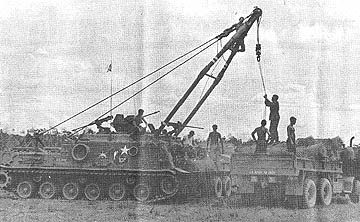 |
A LOTTA MUSCLE - A Dreadnaught VTR helps unload material for a night defensive position. (PHOTO BY SP5 DOUG ELLIOTT) |
| T-I-M-B-E-R - A Rome plow from the 60th Land Clearing Company does a job on the jungle terrain in the Crescent. (PHOTO BY SP5 DOUG ELLIOTT) | 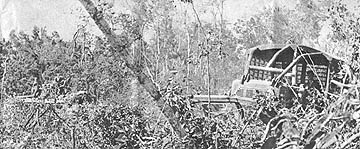 |
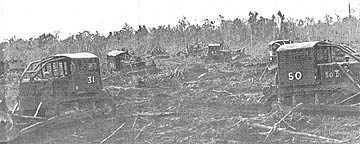 |
ROME PLOWS from the 60th Land Clearing Company clear the terrain and prepare a new night defensive position during the operation in the Crescent. (PHOTO BY SP5 DOUG ELLIOTT) |
Page 8 TROPIC LIGHTNING NEWS July 28, 1969
Arty, Air Strikes Support Regulars
Feature By
SP4 K.C. Cullen
TAY NINH - Tactical air power and overlapping concentrations of
artillery have always been one of the biggest deterrents to enemy infiltration
in Tay Ninh Province. The "King of Battle" and the "Rulers of the
Sky" proved their prowess again recently as they forced an enemy element to
retreat further into his jungle lairs with a massive barrage.
Charlie Company of the 3d Battalion, 22d Infantry, while on a
reconnaissance-in-force mission on the edges of War Zone C, spotted four NVA on
a trail, carrying their weapons on their shoulders.
THE REGULARS engaged the surprised enemy who fled into the nearby
woodline. The Tropic Lightning soldiers pursued and drew fire from an
unknown-size force hidden in the bush. Captain William A. Vestal of
Glendale, Ariz., Charlie Company commander, called Battalion Commander
Lieutenant Colonel Robert B. Carmichael of Columbus, Ga., to bring in the
support.
As the ground troops fell back for a safer and better vantage
point, an explosive storm erupted over the enemy positions. When 155mm
rounds were not exploding, Air Force Phantom jets dropped their 750-pound
ordnance. Gunships filled in between the artillery and air strikes.
After the continuous bombardment was lifted, the Regulars began to
move back toward the area of engagement, but stopped short as night fell.
THE INFANTRYMEN discovered a well-camouflaged trail system before
they returned to their pick-up point. The NVA used clumps of sod to make
the trails invisible from the air.
Eight inch and 155mm artillery pounded the area throughout the
night. Next day, Charlie Company moved toward the woodline as the jets
again dropped explosives on the bunker area.
No enemy resistance was met as the Regulars moved up the
sod-covered trails and the slow, meticulous search of the bunkers began.
By the end of the day 40 of the still-complete bunkers were probed and 30
others, partially or totally destroyed by the bombardment, were checked also.
NINETEEN NVA bodies were discovered in 10 fresh graves throughout
the area. The troopers also found two AK-47 assault rifles along with an
assortment of ammunition.
Fresh clothing and full NVA packs containing a total of 15 pounds
of maps and documents along with 400 pounds of polished rice were hauled from
the bunkers.
"The NVA fled rapidly out of the area, and numerous fresh blood
trails led through the bombed out area to the north," said Vestal. "It
was the best application of tactical air support I have ever seen."
| HAND OFF! Captain William A. Vestal of Glendale, Ariz., passes a rucksack full of captured documents and maps as 1st Lieutenant Hugh E. Stephens of Charleston, S.C., keeps the pilot informed of branches nearby. The LZ was formed by a tactical air strike. (PHOTO BY SP4 K. C. CULLEN) | 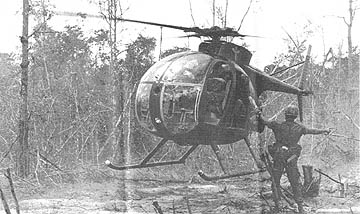 |
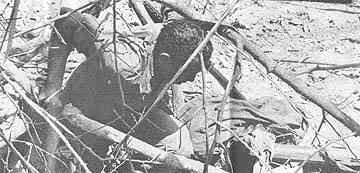 |
A REGULAR from Charlie Company fights his way through the thick underbrush that covers the entrance to one of the NVA bunkers. (PHOTO BY SP4 K.C. CULLEN) |
| MANEUVERING - As an enemy force opens up, soldiers from the 2d Battalion, 22d Infantry, maneuver to flank their position in a thick jungle area. (PHOTO BY SP5 RICK ADAMS) | 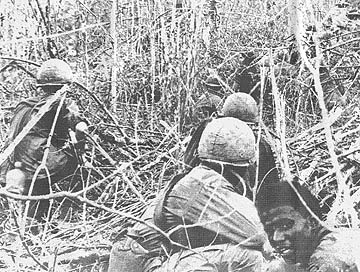 |
BG Black Honored by Thailand Prime Minister
Thanks to
Mack D. Gooding, 15th PID, 1st Bde., for sharing this issue,
Kirk Ramsey, 2nd Bn., 14th Inf. for creating this page.
This page last modified 8-12-2004
©2004 25th Infantry Division Association. All rights reserved.